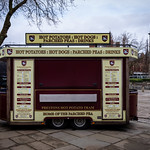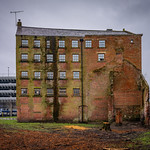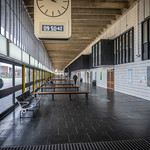- Preston City Council local elections 2024 candidates list set out
- Blog Preston reaches crowdfunding goal for expanded arts and culture coverage
- Harris Institute owners move to squash ‘for sale’ rumours
- “Unacceptable” and “must do better” as Preston records highest rough sleeper count since records began
- Preston Animate cinema reaches highest point in construction
Preston Past: Avenham & Miller Parks (Part 1)
Posted on - 4th April, 2012 - 2:06pm | Author - Paul D. Swarbrick | Posted in - History, Nostalgia, Parks, Preston Guild
Avenham Valley from the Vicarage Grounds,Preston 1862 (Courtesy of Preston City Council)
A very early image of the area that was soon to be transformed into Avenham Park. This photograph was taken from the back of the old Vicarage garden in East Cliff. It appears that sleepers, rails and a quantity of cast iron chairs are stacked at the bottom of the slope in the foreground, possibly belonging the the East Lancashire Railway. The River Ribble with the old Tram Bridge can be seen in the distance along with the former tram engine house and its tall chimney at the top of the hill. Avenham Tower which was built for the Threlfall family in 1847 can also be seen at the top of the hill, to the far left of the photograph.

Jackson’s Cottage on part of the land now known as Avenham Park. (Courtsey of Preston City Council)
Until 1843 six acres of land, which is now occupied by a large part of Avenham Park and owned by Sir Edward Stanley, was known as Jackson’s Gardens, the namesake of the residents of Jackson Cottage as viewed in the adjacent image. The gardens, with ‘concentric walks and an orchard’, at that time privately owned but were open to the public for their leisure. In 1843 this land was purchased by Preston Corporation and along with a further purchase in 1844 of more land to the west. In 1864 the corporation began to implement a plan for a landscaped parkland which was designed by Edward Milner in 1862. During the years up to 1867 all the work to create what was to become Avenham Park was effected using labour of the cotton workers made idle from the great cotton famine and on October 3rd 1867 the completed park was opened by the Duke of Cambridge.
In 1863 Thomas Miller, a wealthy cotton mill owner, bought the land extending from the East Lancashire Railway to the North Union Railway and offered this land to Preston Corporation in order to create a larger park. Because the East Lancashire Railway ran straight through from the north to south sides of the park area it would have been difficult to create one large park and therefore the land to the west of the railway line was developed as a completely separate and different style to Avenham Park; the result was the splendorous Miller Park as we see today.

The Tram Engine House & The Belvedere
One of the features seen in Avenham Park today is The Belvedere building which was removed from Miller Park in 1873 to the exact location of the former TramEngine House, which provided motive power to raise the coal tram carts from the Tram Bridge in earlier times. The adjacent images show the fomer Tram Engine House (left and The Belvedere building (right).

Boer War Memorial On Broad Walk 1926 (Courtesy of Preston City Council)
Another of the well known feature of Avenham Park shown in the adjacent image that most readers will recognise would be the Boer War Memorial which was placed there in 1925 having being removed from the Flag Market in the town centre to make way for the new Cenotaph.
A little further up the hill from the Boer War Memorial still on the Avenham Broad Walk there is the Swiss Chalet which still survives today, and I suspect that there will be many readers who will have very fond memories of that little set-back hideaway from their courting days.

The Rock Gardens at Avenham Park under construction (Courtesy of Preston City Council)
The adjacent image shows the construction in progress of the Rock Gardens, also known as the Japanese Rock Gardens. This was a feature created in the 1930’s which was an extensive refurbishment of the original duck pond. A wide variety of unusual ornamental plants and exotic trees were planted along with a large and spread out rockery. The Japanese Rock Garden was opened on November 12th 1936 by Mayor, James Harrison. In the image you can see the construction work taking place near to the waterfall area. There is the East Lancashire railway bridge, known as Ivy Bridge, in upper centre with the Park Keeper’s Residence slightly to the left of the bridge and the Park Hotel in the background of the upper right.

The Bandstand, Avenham Park 1905
One of the Avenham Park features that has alas faded from view is the former old bandstand which was constructed in 1903 at a cost of £435. The adjacent image shows the wonderful design elegance of the bandstand in the early part of the 20th century along with the Edwardian gentility of the visitors to the park. The bandstand was eventually removed in 1953 when a new and not very attractive ‘acoustical’ bandstand was constructed approximately in the location of the new pavilion. Currently there is no bandstand on the park.

Avenham Park On Easter Monday 1956
| The above image is one that most Prestonians will be able to recognise well, although, the attendance in current times are not generally so good as this 1950’s one was. However, with this year being a Guild year and with the various planned events such as the Easter Bonnet competition and the traditional ‘Egg Rolling’ one never knows. As most Prestonians will remember from their childhood egg rolling was one of the very popular activities which entailed the rolling of delightfully painted hard boiled eggs rolled down the grassy incline of the park until they hit against something at the bottom of the hill and broke the shells to be then consumed by all taking part. This event was taking place even in the 1882 Preston Guild when a writer in the Palatine Note Book 3, stated that ‘in that year, on Easter Monday, he went to see the children roll their coloured eggs in Avenham Park, when there were about 20,000 people present’. Of course, it remains to be seen whether this activity will continue further into this century. It think it would be very nice for that to be the case. Don’t you?
Next Week: Part 2 of this article which looks at the history of Miller Park. |
||
| This is a weekly series showcasing photos each week from the brilliant Preston Digital Archive which is an online archive of images of Preston’s past. |











 Advertisement
Advertisement